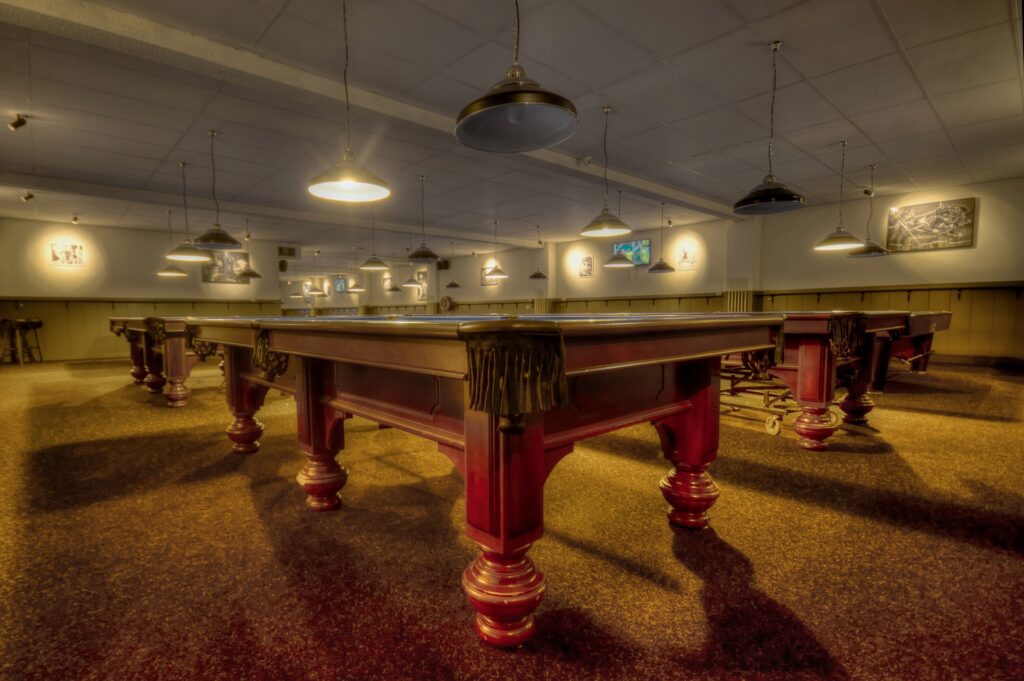As an Amazon Associate we earn from qualifying purchases.
If you feel like your pool balls aren’t rolling the right way it could be because your pool table isn’t leveled properly. If that’s the case, your games would be affected since the balls would roll unusually. You can fix it yourself, you just need to learn how to level a pool table.
How to Level a Pool Table
To level your pool table, you need to measure the level of your pool table and then adjust it so it balances out. There are steps you need to follow and some things you have to prepare.
To level your pool table, you must know how much of it is not leveled. That’s why you should start by measuring the level of your pool table.

Use a Device to Gauge the Level
You can use certain devices that will help you measure the level. The best way to go about it is with the use of a basic carpenter’s level. You can also use analog or digital levels.
Analog carpenter levels usually use bubbles that orient themselves between two lines when the surface is level. It skews to one side if the surface isn’t level.
If you don’t have one, you can use a laser level or even your own smartphone. Plenty of free and cheap apps that provide accurate level-functions. You simply lay your phone on the surface and it will determine the surface level.
Measure the Mid-line of the Pool Table
Place your device or carpenter’s level in the middle of the pool table. It should be oriented in longways. The bubbles in the carpenter’s level will be situated in between the two lines of the glass tube if the pool table is balanced from end to end.
If the bubbles in the glass tube exceed the middle lines, it means you have an unequal level pool table. You will have to raise or lower one or more legs of your pool table.
Measure the Shorter Mid-line of the Pool Table
Turn the carpenter’s level in the opposite direction as well. You also have to measure perpendicular to the long sides of the rectangle and even the short sides. Doing so gives you measurements of the side to side level of the pool table.
Each measurement gives you an idea of what legs need to be adjusted to make the pool table flat and level.
Set Your Level Device on Each Side of the Pool Table
In most cases, the legs of the pool table cause it to be uneven. One leg or multiple might be lower than the other three legs on the pool table.
In order to spot it, place the carpenter’s level close to the edge of each side of the pool table. This will give you a more accurate reading.
- Move to every side and corner of the pool table while checking the level of the extremity of the lean. Identify the corner with the most extreme lean.
- In some cases, you will get unusual readings. This may be because the floor of your house itself isn’t level. Don’t worry, you can still make adjustments the same way, it just will take more of your time.
Find the Lowest Spot
The lowest spot should dip or the cue ball should move in the same direction whichever corner you place it. If the level dips more than the other, that’s the corner you should start to adjust.

When you find the lowest corner, place an 8 ball in the nearest pocket to mark it. That way, you’ll be able to remember where it is and adjust accordingly.
Other Alternatives to Measure the Level of Pool Table
If you don’t have a carpenter’s level and you can’t use your smartphone as a level device, you can use other alternatives. Though it may not produce accurate results as much as the carpenter’s level.
Use a Pool Ball to Check for Practical Balance
You can check the level of your pool table with the use of your own cue ball. Even if you’re playing by yourself, it’s simple to do but you need to know that it might also give you less accurate measurements.
- Roll the cue ball onto a section of the table as straight as you can control.
- Position your eyes evenly with the plane of the table and observe the path of the cue balls.
- Check if the cue ball rolls off course heading into a particular side or if it is consistent.
- Repeat the process on every section of your pool table.
- This method needs you to hold the stick to move the cue ball extremely straight. It will produce a less accurate measurement of level, yet it does the job of spotting uneven surfaces.
Use a Flat Piece of Glass and a Marble to Gauge the Balance
This is another way to check the level of your pool table. You just need a piece of glass and a marble.
- Place a piece of glass in the middle of the pool table.
- Place a marble on the middle of the piece of glass. If the pool table is level, the marble should stay in its place. Adjust the pool table to where the marble rolls off to.
- Repeat the process on every side of the table. The glass and marble should be 2 to 3 inches from every pocket on the pool table.
Adjusting the Height of the Pool Table
Now, that you’ve identified the uneven corner of your pool table, it’s time to adjust it so all corners of your pool table are level.
Check Your Pool Table Manual
Before you try anything yourself, you should first read your pool table manual. Most manufacturers make their pool tables adjustable. You can easily level them no matter what surface it’s on. Just follow the instructions in the manual.
Some pool tables have metal plates. You can use them to add or remove which raises or lowers the side of the pool table. Other pool tables use adjustable legs. The feet can be screwed clockwise or counterclockwise to adjust the level.
What If I Lost My Manual?
If you lost your manual, you can look at the legs and see how they’re put together. Also, check if they have adjustable components. If it isn’t adjustable, you can use shims and other tiny adjustments to level your table.
If the pool table has screw-in legs, you can usually raise them by turning the legs to the right and lowered by turning the legs to the left. If it’s too tight don’t force it.

Tighten All Attachment Screws Under the Table
Another reason why your pool table surface isn’t level is that some screws are loose. The bolts and screws in your pool table can loosen over time which causes the uneven pool table level.
If you tighten up all the attachment screws, you might end up with a level pool table without needing to adjust the height. Pool tables have different screws so you might need different types of screwdrivers to tighten them.
Raise the Lowest Table Leg
If you have an adjustable pool table, raise the leg with the lowest level by one degree. It’s the least amount that can be adjusted. You have to increase it to a minimum for better adjustment accuracy.
Leave the carpenter’s level on the pool table so you can check for changes. If you over adjust it with just the minimum adjustment, lower it back to its original state and use shims to make smaller adjustments.
Adjust Other Table Legs Accordingly
You will sometimes encounter making lots of tweaking on different sides to get your pool table completely level. You will have to spend a lot of time adjusting and checking the level so you need a lot of patience.
An efficient way to do this is to place your carpenter’s level on your pool table while you are adjusting and check on it as you adjust.
Another option you can do is to use shims so you can leave over adjusted legs as they are. However, you will also have to do it repeatedly to get the right level.
Use Shims to Adjust the Level
Shims are small, tapered shards of wood. You can use them to fill gaps and adjust the height of things more commonly used in pool tables.
You can buy them at the carpentry sections of any hardware or home goods store. They come in different packages and variable sizes.
You can trim the shims so that it fits underneath the feet of the table if needed. Some people trim theirs because it doesn’t look pleasing to see.
Getting Help Makes It Easier
Having one or more assistance can make the work a lot easier. Especially if you’re adding shims to your pool table.
Have one or more assistants lift the corner of the pool table that needs adjusting. Place a shim underneath the leg while your assistant slowly lowers the leg.
Continue adding shims underneath the legs until the pool table is level. Move to other corners if it’s needed.

The Level Doesn’t Have to Be Perfect
You can’t expect your pool table to be perfectly level. You just have to keep it at a level where it doesn’t affect the game badly. If you want to be perfect, you will end up adding and removing shims over and over.
Do the cue ball test and roll the ball over if it’s right for your standards.
Tools and Materials You Might Need
Now that you know what to do to level a pool table, let’s summarize all the things that you might need. The work can be difficult if you don’t prepare the needed tools and materials. Some tools make the process a lot faster and easier.
Choose what method you are going to follow and you can cross out some of the things on this list.
- Carpenter’s level (analog or digital)
- Small piece of glass
- Marble
- Cue ball
- Smartphone with level features
- Wooden shim
- Screwdriver (different types if necessary)
Avoiding Common Leveling Problems
When you repeat the process of leveling your pool table and adjusting your shims, you might likely end up with loosened screws, especially slate screws. This might affect the level of your pool table and it might start spinning as you tighten the legs.
Make sure you check on it before you start adjusting for the level of your pool table. Tighten them and keep them in place so they won’t loosen during the leveling process.
How Pool Tables Can Be Leveled
There are three approaches for leveling your pool table. Before that, check on your owner’s manual and follow the instructions. You can adjust a pool table in 3 ways.
- Metal plates (shims): if your pool table comes with metal plates, all you need is a carpenter’s tool and extra hands to adjust your pool table. However, take note that they might not fit your adjustments so you might end up buying extra shims.
- Adjustable legs: with adjustable legs, you can just have your smartphone or carpenter’s level. Simply adjust the legs in accordance with the carpenter’s level measurements.
- Wooden shim: most cheap pool tables don’t come with metal plates or adjustable legs. That’s why you will have to resort to using wooden shims. We have already mentioned how to use them and they’re really effective.
Conclusion
You can approach leveling your pool table in different ways depending on what pool table you own. The consistent thing about the three approaches is the process. Measure the level and adjust the height so the pool table is leveled.